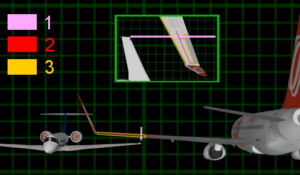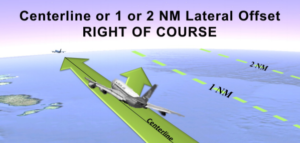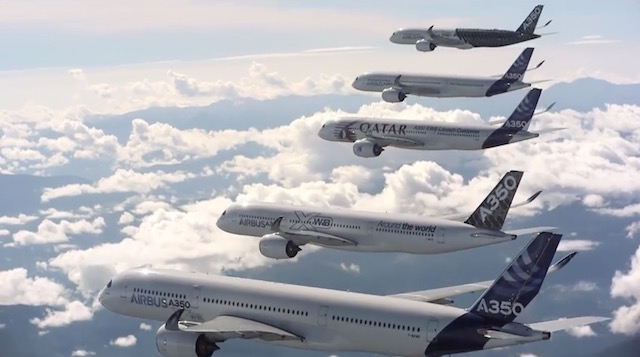In Short: Strategic Lateral Offset Procedures (SLOP) costs nothing and increases flight safety. If the airspace permits it, you should be “randomly” offsetting, especially across the North Atlantic. Left is for losers – don’t SLOP left of track.
Update: August 2019 – you can now “MicroSLOP” in the NAT. Check out the changes.
We had a discussion in OpsGroup recently about SLOP (Strategic Lateral Offset Procedures) and it elicited some interesting responses, as well as some confusion.
So – Why, How and Where should you SLOP?
Why?
 GPS technology allows modern jets to fly very accurately, too accurately it turns out sometimes! Aircraft can now essentially fly EXACTLY over an airway/track laterally (think less than 0.05NM), separated only by 1000FT vertically. A risk mitigation strategy was proposed over non-radar airspace to allow pilots to fly 1-2 nautical miles laterally offset from their track, randomly, to increase flight safety in case of any vertical separation breakdown.
GPS technology allows modern jets to fly very accurately, too accurately it turns out sometimes! Aircraft can now essentially fly EXACTLY over an airway/track laterally (think less than 0.05NM), separated only by 1000FT vertically. A risk mitigation strategy was proposed over non-radar airspace to allow pilots to fly 1-2 nautical miles laterally offset from their track, randomly, to increase flight safety in case of any vertical separation breakdown.
How did we get here?
Navigation paradox
What we just described is known as the navigation paradox. The research shows that “increases in navigational precision” actually increases the collision risk – huh?
 Here are some interesting stats to consider:
Here are some interesting stats to consider:
- In a simulation, aircraft cruising at random altitudes have five times fewer collisions.
- During a 2000 study, it was shown that hemispherical cruising altitude rules resulted in six times more mid-air collisions than random cruising altitude non compliance.
- If more randomness was applied to the hemispherical cruising level model, the navigational paradox risk could have been largely reduced and up to 30 midair collisions avoided (up to 2006). Including the tragic GOL 2006 accident.
So we get it; the rules of the air, sometimes inject risk to flight safety due to their lack of randomness.
A way to reduce risk and inject randomness?
 It was 2004 when SLOP was adopted in the most congested non-radar airspace in the world, namely the North Atlantic.
It was 2004 when SLOP was adopted in the most congested non-radar airspace in the world, namely the North Atlantic.
Although the Navigation Paradox is the reason SLOP was introduced and continues to be implemented, there are some nice risk mitigation side-effects too: wake turbulence reduction (at times), contingency buffers if you experience severe turbulence and can’t maintain altitude (“level busts”), etc.
SLOP therefore reduces the risk between traffic which is not operating in accordance with the correct air traffic control clearance or where an error has been made in the issue of an air traffic control clearance.
Still, there is a large number (>40%) of aircraft not adopting these procedures even though they are now mandatory on the NAT.
If >40% of pilots are using SLOP 0 (meaning no offset at all), what does that matter? That means half the flights are operating over the same lateral paths and all it takes is one minor vertical deviation for there to be a significant loss of separation.
The daily NAT track message always reminds pilots to employ SLOP procedures:
FOR STRATEGIC LATERAL OFFSET AND CONTINGENCY PROCEDURES FOR OPS IN NAT FLOW REFER TO NAT PROGRAMME COORDINATION WEBSITE WWW.PARIS.ICAO.INT. SLOP SHOULD BE STANDARD PROCEDURE, NOT JUST FOR AVOIDING WX/TURB.
How should you SLOP?
 Consider some best practice advice:
Consider some best practice advice:
- LEFT IS FOR LOSERS – never offset LEFT. On bi-directional routes a LEFT offset will INCREASE collision risk rather than decrease it. There are areas in the NAT Region where bi-directional traffic flows are routinely used. And there are times when opposite direction traffic may be encountered in any part of the Region. Once upon a time (between introduction of RVSM and pre-SLOP, it was ok to go LEFT, not anymore!)The only exception would be in certain airspace where ATC request you to SLOP LEFT (e.g. China).
- The system works best when every 2 out of 3 crossings you fly, you apply an offset. Shanwick says this generally means at least 1 out of 3 aircraft are slopping.
- You don’t need to ask ATC for approval; you can SLOP from the NAT entry point to the NAT exit point.
- Only offset if your FMC has the function to do so – do not do it manually.
- Good airmanship applies here. What’s happening around you? Who is above, below and near you on the same track. Co-ordinate on 123.45 if needed.
- 2nm RIGHT is the maximum approved SLOP.
- Flip a coin to decide like some do! Captain is PF? 1R going west; First Officer 2R going east etc. Studies show that on the NAT, 40% do 1R and only 20% go 2R. Don’t be afraid to go the full 2R!
- If you are overtaking someone, the ICAO guidance in NAT DOC 007 is to apply SLOP so as to create the “least amount of wake turbulence for the aircraft being overtaken”.
Where though?
 Our friend Eddie at Code 7700 gave a great comprehensive list so here it is verbatim.
Our friend Eddie at Code 7700 gave a great comprehensive list so here it is verbatim.
- Africa, almost all remote locations employ SLOP. Check the Jeppesen Airways Manual / Air Traffic Control / State Rules and Procedures – Africa) to be sure. Rule of thumb: if you are in radar contact, you probably should not SLOP.
- One notable exception where they don’t want you to SLOP is in the HKNA/Nairobi FIR. The AIP states: “SLOP is not applicable in the Nairobi FIR due to efficient surveillance and communication systems.” (We do remind you however that recently in the Nairobi FIR, a 767 and 737, both at FL370 came a little too close for comfort).
- Australia is another special case. You may only offset in the OCA, and, if you’re still on radar, then you need to tell ATC, both when starting the offset, or changing it. Within domestic CTA airspace, you must fly centerline. (According to Australian guidance in Jeppesen Pages).
- China, on routes A1, L642, M771, and N892 (according to China guidance in Jeppesen Pages). In some areas they employ their unique SLOP offsets, but do allow the standard 1 nm and 2 nm offsets.
- New York, Oakland and Anchorage Oceanic FIRs (according to U.S. FAA guidance).
- Oceanic airspace in the San Juan FIR (according to U.S. FAA guidance).
- North Atlantic Track Region: SLOP is mandatory (according to the North Atlantic Operations and Airspace Manual).
- The Pacific (including the NOPAC, Central East Pacific (CEP) and Pacific Organized Track System (PACOTS) (according to U.S. FAA guidance).
- South Pacific airspaces (according to U.S. FAA guidance).
FAQ:
- Should I SLOP crossing the Atlantic even if I’m on a random route or above the published NAT FL’s?
Yes! You should especially do it then. There is a higher chance of opposite direction traffic. That extra mile or two (randomly selected of course) could be a life saver!
- What about micro-slop?
That is lateral offsets between 0 and 1 nm (0.1 etc). ICAO mentions “LOP provisions as specified in ICAO PANS-ATM Doc.4444 were amended 13 November 2014 to include the use of “micro-offsets” of 0.1 Nms for those aircraft with this FMS capability. Appropriate guidance for the use of this amended procedure in the North Atlantic is under study and hence pending.”
And now, since August 2019, this is beginning to be approved for operations on the NAT. Read the update!
We might have missed something or maybe we didn’t cover your specific question?
Drop us a line and will do our best to answer.
Bottom line, SLOP costs nothing but increases flight safety.
More on the topic:
- More: What’s Changing on the North Atlantic
- More: Timeline of North Atlantic Changes
- More: Spoofed Before the NAT? Here’s What to Do
- More: Shanwick Delays OCR Until Post-Summer 2026
- More: Blue Spruce Routes Are Gone (But You Can Still Fly Them)
More reading:
- Latest: Mexico Customs Surprises: Pills, Vapes, and Laptop Rules
- Latest: Greenland NAT Alternates: Dec 2025 Update
- Latest: Crossing the Quiet South: From Australia to Argentina
- Safe Airspace: Risk Database
- Weekly Ops Bulletin: Subscribe
- Membership plans: Why join OPSGROUP?











 Get the famous weekly
Get the famous weekly 






Great information on the different country regulation applications! Thanks. I had a concern with an oceanic flight example PHNL to CYYC. Flight Level 330 Eastbound flying a B737-800, with a heavy A380 at FL340 tracking SW. Strong westerly winds of 150Kts at these altitudes. Offsetting 1 or 2 NM right positions our aircraft downwind of this strong airflow. I haven’t the wake movement data downward for the A380. My concern is by operating SLOP to the right could cause a wake encounter with either 1 or 2 NM SLOP. Our aircraft are operating on the “ZULU” track. Staying on the assigned track, as the A380 is maintaining, could keep us out of the potential wake encounter, but totally release the collision avoidance quality of the SLOP.
Thanks for the great information in your article. Look forward to your reply.
Cheers!